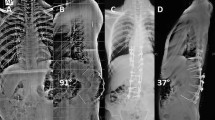Abstract
Spinal tuberculosis is the most common cause of severe kyphosis in many parts of the world. Three percent of patients treated conservatively end up with a deformity greater than 60 degrees which can cause serious cosmetic, psychological, cardio-respiratory and neurological problems. Severe kyphotic deformities are usually the result of childhood spinal deformities and ‘Spine at risk’ radiological signs are helpful to identify children at risk of deformity. In children, a severe type of collapse, termed as ‘Buckling Collapse’ is also noted where the kyphosis is more than 120 degrees. Risk factors for buckling collapse include an age of less than seven years at the time of infection, thoracolumbar involvement, loss of more than two vertebral bodies and the presence of radiographic ‘Spine-at-risk’ signs. In correction of established deformity, posterior only surgery with a variety of osteotomies is now preferred. In patients with deformity of more than 90 degrees, an opening-closing wedge osteotomy must be done to prevent neurological deficit.









Similar content being viewed by others
References
Moon MS, Lee MK (1971) The changes of the kyphosis of the tuberculous spine in children following ambulant treatment. Korean Orthop Assoc 6:203–208
Parathasarathy R, Sriram K, Satha T et al (1999) Short course chemotherapy for tuberculosis of the spine: a comparison between ambulant treatment and radical surgery: ten year report. J Bone Joint Surg 81B:464–471
Moon MS (1997) Tuberculosis of the spine, controversies and a new challenge. Spine 22:1791–1797
Moon MS, Kim I, Woo YK, Park YO (1987) Conservative treatment of tuberculosis of the thoracic and lumbar spine in adults and children. Int Orthop 11:315–322
Tuli SM (1995) Severe kyphotic deformity in tuberculosis of the spine. Int Orthop 19:327–331
Yau ACMC, Hsu LCS, O’Brien JP, Hodgson AR (1974) Tuberculosis kyphosis-correction with spinal osteotomy, halo-pelvic distraction and anterior and posterior fusion. J Bone Joint Surg 56A:1419–1434
Rajasekaran S (2001) The natural history of post-tubercular kyphosis in children: radiological signs which predict late increase in deformity. J Bone Joint Surg 83B:954–962
Rajasekaran S (1999) A longitudinal study on the progress of deformity in children with spinal tuberculosis. PhD Thesis. Chennai, India, Tamilnadu Dr.MGR Medical University
Rajasekaran S (2007) Buckling collapse of the spine in childhood spinal tuberculosis. Clin Orthop Relat Res 460:86–92
Rand C, Smith MA (1989) Anterior spinal tuberculosis: paraplegia following laminectomy. Ann R Coll Surg Engl 71(2):105–109
Upadhyay SS, Saji MJ, Sell P et al (1994) The effect of age on the change in deformity after radical resection and anterior arthrodesis for tuberculosis of the spine. J Bone Joint Surg 76A:701–708
Hodgson AR, Stock FE (1960) Anterior spinal fusion for the treatment of tuberculosis of the spine. J Bone Joint Surg 42A:295–310
Medical Research Council (1982) A 10 years assessment of a controlled trial comparing debridement and anterior spinal fusion in the management of tuberculosis of the spine in patients on standard chemotherapy in Hong Kong: VIII report. J Bone Joint Surg 64B:393–398
Oga M, Arizono T (1993) Evaluation of the risk of instrumentation as a foreign body in spinal tuberculosis: clinical and biologic study. Spine 18(13):1890–1894
Ha K-Y, Ryoo SJ et al (2004) Adherence and biofilm formation of staphylococcus epidermidis and mycobacterium tuberculosis on various spinal implants. Spine 30:38–43
Chen WJ, Wu CC, Jung CH et al (2002) Combined anterior and posterior surgeries in the treatment of spinal tuberculous spondylitis. Clin Orthop Relat Res 398:50–59
Sunderaraj GD, Behera S (2003) Role of posterior stabilisation in the management of tuberculosis of the dorsal and lumbar spine. J Bone Joint Surg Br 85-B:100–106
Klockner C, Velencia R (2003) Sagittal alignment after anterior debridement and fusion with or without additional posterior instrumention in the treatment of pyogenic and tuberculous spondylodiscitis. Spine 28(10):1036–1042
Moon MS, Woo YK, Lee KS et al (1995) Posterior instrumentation and anterior interbody fusion for tuberculous kyphosis of dorsal and lumbar spines. Spine 20:1910–1916
Talu U, Gogus A (2006) The role of posterior instrumentation and fusion after anterior radical debridement and fusion in the surgical treatment of spinal tuberculosis: experience of 127 cases. J Spinal Disord Tech 19:554–559
Benli IT, Acaroglu E (2003) Anterior radical debridement and anterior instrumentation in tuberculosis spondylitis. Eur Spine J 12(2):224–234
Benli IT, Alanay A, Akalin S et al (2004) Comparison of anterior instrumentation systems and the results of minimum 5 year follow-up in the treatment of tuberculosis spondylitis. Kobe J Med Sci 50(6):167–180
Ozdemir HM, Kemal US (2003) The role of anterior spinal instrumentation and allograft fibula for the treatment of Pott disease. Spine 28(5):474–479
Yilmaz G, Selek HY et al (1999) Anterior instrumentation for the treatment of spinal tuberculosis. J Bone Joint Surg 81-A(9):1261–1267
Dai LY, Jiang LS, Wang W et al (2005) Single-stage anterior autogenous bone grafting and instrumentation in the surgical management of spinal tuberculosis. Spine 30:2342–2349
Guven O, Kumano K, Yalcin S et al (1994) A single stage posterior approach and rigid fixation for preventing kyphosis in the treatment of spinal tuberculosis. Spine 19:1039–1043
Govender S, Parbhoo AH (1999) Support of the anterior column with allografts in tuberculosis of the spine. J Bone Joint Surg 81B:106–109
Jain AK, Aditya VM (2007) Kyphus correction in spinal tuberculosis. Clin Orthop Relat Res 460:117–123
Bezer M, Kucukdurmaz F (2007) Transpedicular decancellation osteotomy in the treatment of posttuberculous kyphosis. J Spinal Disord Tech 20:209–215
Kawahara N, Tomita K, Hisatoshi B et al (2001) Closing–opening wedge osteotomy to correct angular kyphotic deformity by a single posterior approach. Spine 26:391–402
Rajasekaran S, Vijay K, Shetty AP (2010) Single-stage closing-opening wedge osteotomy of spine to correct severe post-tubercular kyphotic deformities of the spine: a 3-year follow-up of 17 patients. Eur Spine J 19(4):583–592
Author information
Authors and Affiliations
Corresponding author
Rights and permissions
About this article
Cite this article
Rajasekaran, S. Kyphotic deformity in spinal tuberculosis and its management. International Orthopaedics (SICOT) 36, 359–365 (2012). https://doi.org/10.1007/s00264-011-1469-2
Received:
Accepted:
Published:
Issue Date:
DOI: https://doi.org/10.1007/s00264-011-1469-2




